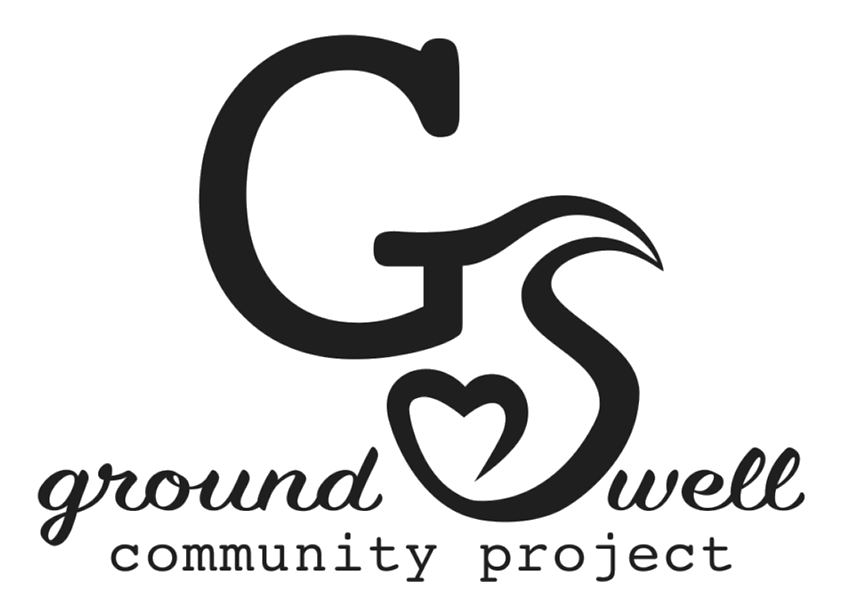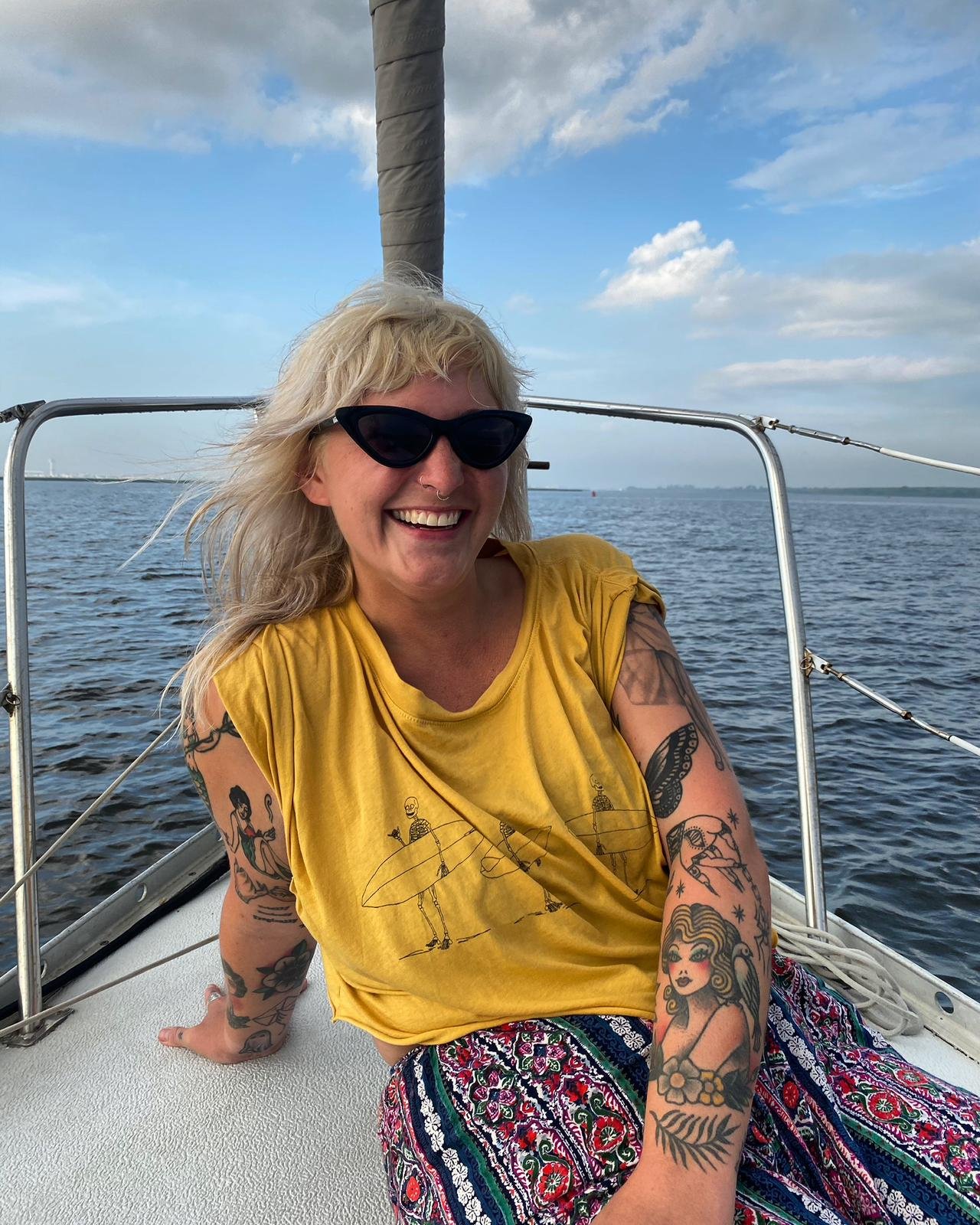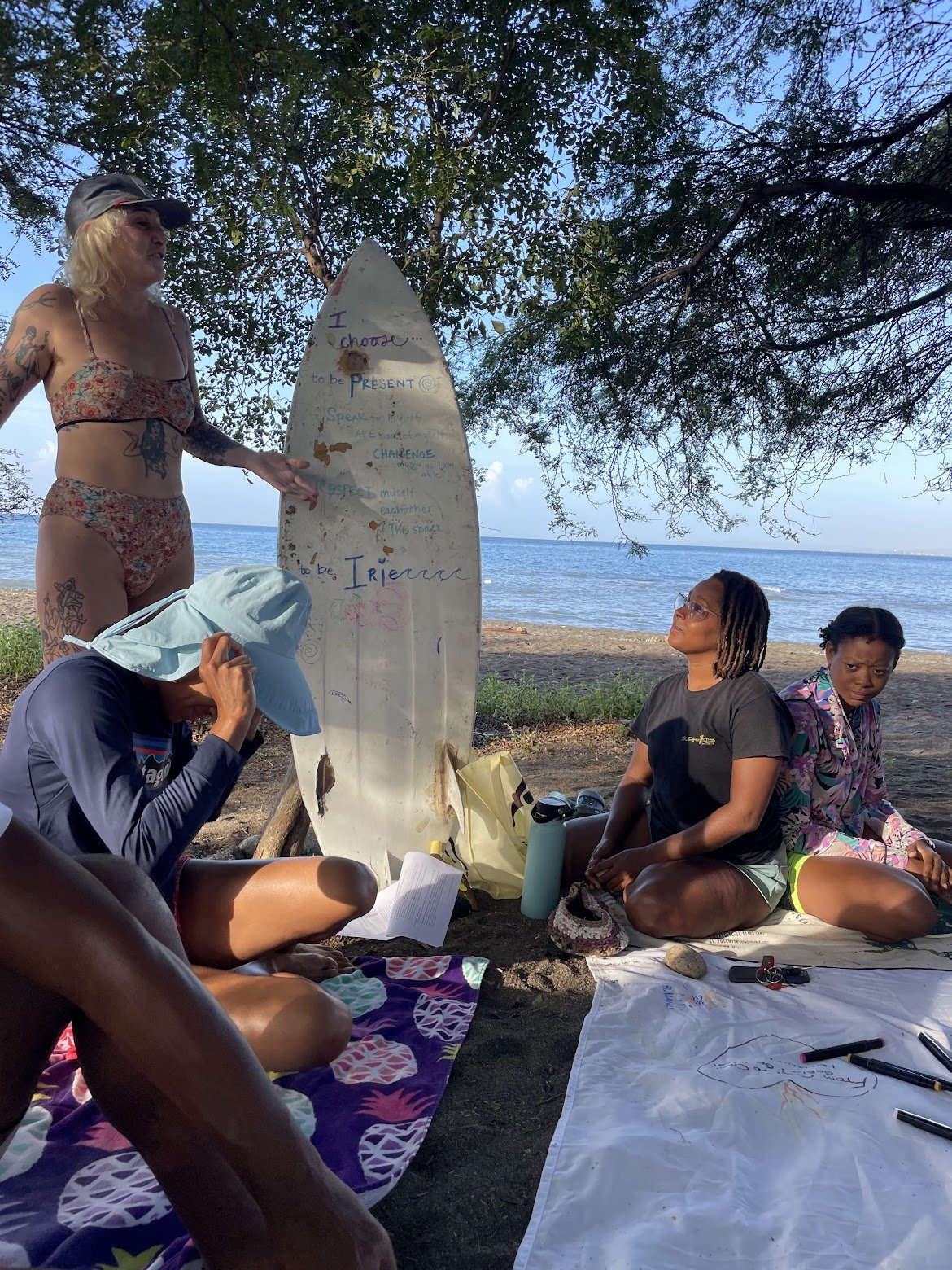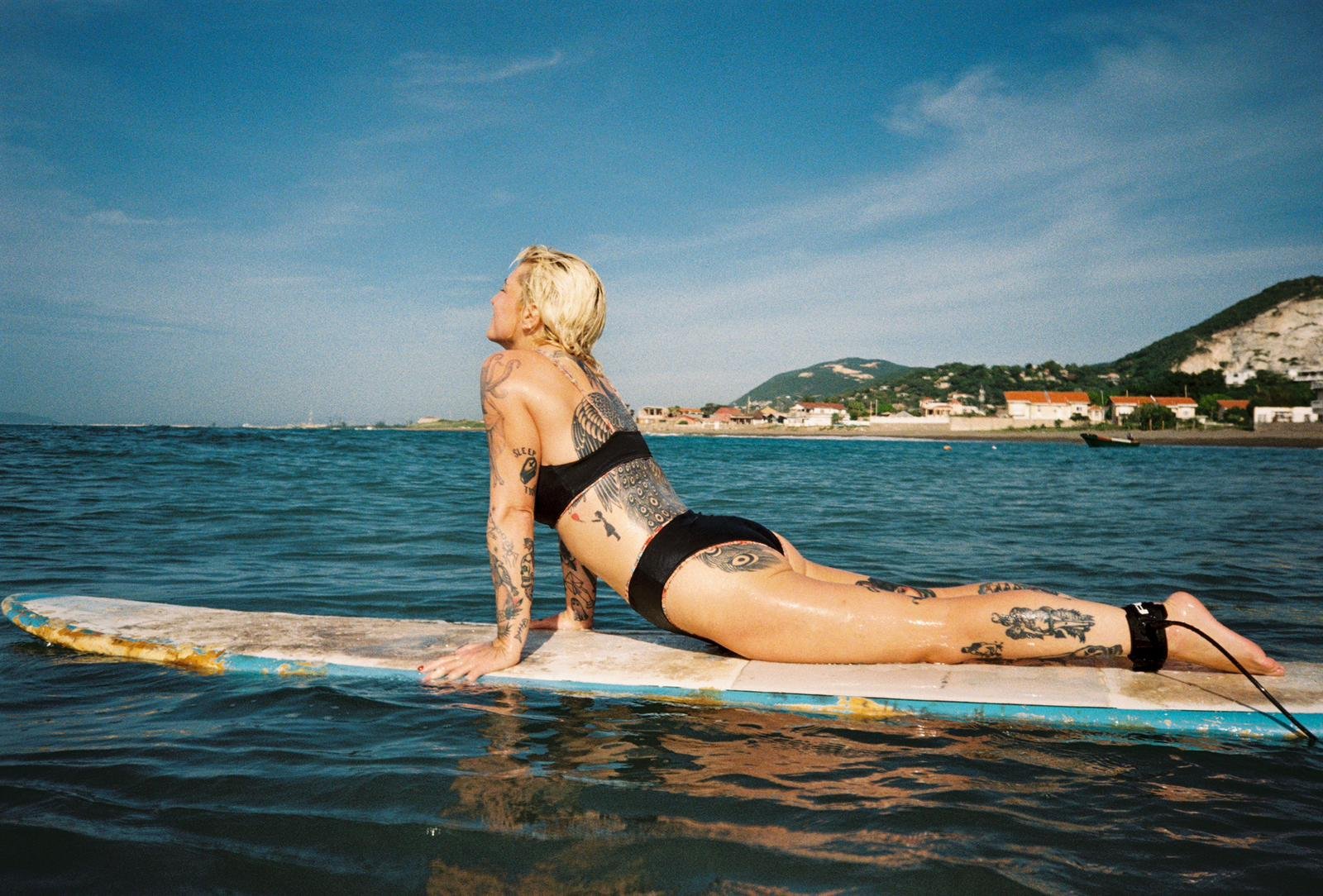Beyond surfing: Jamaica Surf Therapy Facilitator Retreat Reflection by Gina Jurlando
My name is Gina Jurlando and I am a surf sister! Growing up, I spent all of my free time on the water, learning to surf at seven years old and not stopping until I was about 18. As a child, I grew up traveling the world with my parents, backpacking to remote locales and connecting with people all over the globe. My idyllic childhood was interrupted by my father’s addiction issues and after years of trauma and failed traditional therapy, I realized the best thing for me was to self-heal through surfing. After a few years hiatus from it, I realized how helpful being on and around the ocean was for my mental health and began again, relearning to surf after I moved on to a boat in the small coastal community outside of NYC called Rockaway Beach. It was through this small community that I connected with other people who were as in tune with Blue Mind as I was and I formed the femme-focused beginner surf club and community service group Yeasty Boys to encourage everyone to learn how to surf and connect with themselves and Mother Ocean while thriving in community and doing what we could to protect the ocean. It was in Rockaway Beach that I learned the true meaning of community and was able to use my skill set to volunteer with Rockaway Mutual Aid during the pandemic and beyond and help run the Women’s Surf Film Festival as the volunteer organizer for the past few years.
This September I was introduced to Natalie Small, the founder of Groundswell Community Project and had the opportunity to hear her speak on a panel during WSFF. Hearing Natalie explain her journey of founding Groundswell and her journey into bringing surf therapy to the masses was probably one of the most “a-ha moments” I’ve ever had in my life. I had never known that my connection to the ocean and surfing as a way to heal and connect to myself was considered surf therapy and the fact that other people were doing the same was incredible to learn.
As many who know me can attest to, I’m the type of person who finds something new to be interested in, throws myself into it entirely and sees where it takes me. But I was scared to open up the can of worms I had so tightly packed over the years of dealing (or not dealing) with both my own trauma and my entirely lackluster experience with more traditional therapy methods. I’m not a particularly spiritual person and I was worried it would be too “woo woo” for me or that I would crumble in the face of having to deal with my own issues in order to best hold space for others. But I chose to give it a go and I am SO glad I did. I found Natalie after the panel, asked her a ton of questions and by the end of the week had registered for a surf therapy for trauma recovery training.
The Level 1 Surf Therapy for Trauma Recovery training was held over the course of two weeks in a virtual format. As someone who had never taken a psychology class in school, I was worried I would be deeply out of my element and not understand the science behind trauma recovery or even the basics on how the brain works and responds to trauma. I’m a huge fan of studying and read every single recommended reading before the course began to prepare myself but still wasn’t sure what to expect. However, I was pleasantly surprised. The way the information was presented through the lens of nature and the ocean allowed me to make connections to the science in a way I don’t think a traditional psychology class could have done. The course utilized experiential embodied learning to explore the somatic therapy definition of trauma and its effects on the brain, body, and community. We discovered how surfing mother ocean’s waves can be a powerful therapeutic healing modality for the individual and community. I particularly enjoyed the introduction of the grounding guidelines and what makes surf therapy more than just a surf lesson. Any thoughts I had of the material being too “hippy dippy” quickly went out the window as we discussed the way different parts of our brain react to different chemicals and triggers. As a more analytically minded person, the science I was so afraid I wouldn’t understand formed a great basis for why surf therapy works specifically for trauma. It was amazing to see that my classmates came from all over the world and brought their individual experiences and learning styles to the coursework and that we were all connected by a desire to help others.
By the end of October I had my first level certification and headed out for a week long surf therapy facilitator training retreat in Jamaica. I had convinced my friend Ashley, the head of AmpSurf in NY to attend, but once again, I had deep resistance and imposter syndrome when I learned we would be the only two non-mental health professionals in attendance. Our trip started off with a bang (literally). As we packed up to head to Jamnesia Surf Camp, a large earthquake hit Jamaica. Like the waterwomen we are, we ran to the window not to survey damage but to see if any swell was rolling in before we realized we should probably get away from the glass. Once the island settled, we hopped in a cab and made our way to the camp.
Jamnesia Surf Camp is run by the Wilmot family, often referred to as the “first family of surfing in Jamaica.” Jamnesia is located in Bull Bay, eight miles east of Kingston and is an inclusive compound right on the beach offering Jamaican eats, rustic accommodations and regular Reggae jam sessions with a beach bonfire and irie floating through the air. Walking into the camp felt like home, not only for the kind welcomes, but because Jamnesia is literally the Wilmot family's home. Throughout the week neighbors, friends and family members drifted through, offering stories of Jamaica’s surfing history, awesome music, or a friendly smile. Generations of the family live and work at Jamnesia and we felt like part of the family right away.
As we introduced ourselves to the other participants, we learned that almost every person in attendance had felt the same resistance that we had to coming (even though we all signed up for it), which made us all feel closer. Some were there for surf therapy, others were there for facilitator training, but once again, we were all connected by a love for the ocean and a desire to learn how to help heal ourselves and others. We started the day with introductions and our first grounding circle, where we learned we wouldn’t know what we were doing each day until the morning (a both exhilarating and terrifying prospect for a planner such as myself) and then headed out to the beach for our first exercise. Once again, there was something special about being able to learn about surf therapy with the sun on our faces and the gentle waves lapping the shore behind us as we embodied sea creatures, discussed blue and red mind theory, and collected items from the shore that spoke to us. After the first session we were told “go play in or around the ocean,” which was music to my ears. Though there were no waves the entire trip, I was itching to get on a surfboard and just paddle around. We surfed, swam, snorkeled, walked along the beach and got to know each other while floating in the warm waters of Jamaica. That afternoon we began carving calabash bowls that we would use for every meal, a nod to the history of indigenous Jamaican people and something that many still use today. We ended the first night with an insanely good vegan meal (every meal was better than the last) and settled in to hear the Selkie story around the campfire. We were given prompts from the story each night and asked to journal and consider how it related to our lives and surf therapy, which was a great exercise throughout the week.
If I tried to recap every day in Jamaica this blog would be a novel, but some of my favorite experiences were ones I hadn’t expected. One night Billy Wilmot gathered us around the fire and told stories of his travels around the world with his band and the history of Jamaica and starting Jamnesia. Another night Claudet Wilmot told folk tales and sang traditional folk songs around a candle (it was too wet for a bonfire). Peta taught us yoga under a tree of life and we explored the night market and local skatepark. We got to explore the coast and surf since there weren’t waves out front of Jamnesia like usual, then were treated to lunch cooked by local fisherman. Some of my favorite times were our downtime where we gathered in the open air kitchen to play games, drink Red Stripe and talk about nonsense like old friends. We never felt forced to participate and thus were able to relax while getting a top notch education!
The overarching theme of this retreat for me was that it was a real experience, not a manufactured surf retreat where you go to the top tourist spots and don’t actually talk to people or learn their stories. I felt connected to the people, the land, and of course, the ocean. Each day was new and exciting and combined elements of surf therapy, wellness, play, and deep connection with each other. The focus on indigenous wisdom and equity was particularly important to me and one of the main reasons I loved the Groundswell curriculum so much. The people who were strangers we met on our first day became family as we talked about our dreams and aspirations, what led us to this sort of retreat, and our individual connection to the sea. Everyone had different experiences and backgrounds, but we all had a shared love. It takes a certain kind of person to decide they want to heal, and especially heal through a less traditional modality, but we all were inherently connected. It was surprising and affirming to hear that though we all were there for different reasons, many of us were leading community projects back home and all felt surf therapy could help our various groups in different ways.
None of the retreat’s magic would have been possible without our amazing facilitators Imani, Ludine, Shelly, Natalie, and Natasha. In a space that could have been overwhelming, I felt safe and supported throughout the entire retreat. I was able to ask questions and get advice without fear of judgment. Not only were they amazing educators, they were fun! There was no power dynamic aspect to worry about and I learned so much from them about how to facilitate in a supportive way. When it was announced that at the end of the retreat we were going to facilitate a session for local families, I felt fully prepared and incredibly excited to put all we had learned into practice.
Getting to co-facilitate a session with the other retreat participants was one of the most amazing experiences of my life. Participants ranged in age from toddlers to adults and everyone was open to learning and being involved. Working as a team to delegate tasks and develop the program based on Groundswell’s guidelines was extremely collaborative, which I believe all surf therapy should be. We each chose sections based on our interests or talents to present to the group then got in the water to help participants connect with themselves and Mother ocean. Helping parents and children catch their first waves ever or even just getting them used to being in the water was a heartwarming experience and one that I will carry with me forever. I had helped people learn to surf before but there was something incredibly moving about being able to do it through the lens of surf therapy and knowing something I had helped facilitate would maybe help them in the future. As I write this the memory still puts a huge smile on my face and I don’t think that will ever change. Getting to not only learn how to facilitate surf therapy sessions but also get to experience the tangible effects of it on both myself and participants solidified my decision that this was something worth pursuing. Not only was I learning something new, Groundswell also provided literally all the materials we needed to take what we had learned and bring it home with us to create our own surf therapy programs or continue facilitating theirs.
Upon returning home after the retreat, I completed my facilitator coursework virtually with self-led facilitator trainings on Sea & Sand sessions, grief sessions and more. The courses were pre-recorded but I still felt connected to the material and enjoyed seeing some of the facilitators I had met in Jamaica in the recordings! I particularly enjoyed being able to experience the material through the self led learning model, as I was able to pause and reflect, rewatch portions I needed more clarity on, and know I will always have the trainings at my disposal in the future to revisit and learn more from.
The final step of certification was a call with Natalie. I didn’t know what it would entail, but by that point, I had learned to let go of expectations and just be. On our call we discussed what I had learned in the trainings and at the retreat, how Groundswell could grow and support facilitators, what my plans were for the future once I was certified and any pain points or hesitations I still had. As always, I felt supported and prepared for the journey ahead.
I am extremely proud to announce that as of today I am now *officially* a certified surf therapy facilitator! I’m taking this winter to start speaking to my community to see what forms of surf therapy would work for them/ develop a curriculum around it and to continue to develop my knowledge through trainings and continuing education. I’ve started Ride the Tide Surf Therapy in NYC and NJ and I hope to begin hosting community sessions this spring but in the meantime, I’m taking the time to really do my research and chat with anyone who is interested in surf therapy. Whether they just want to understand exactly what it is and why I’m so suddenly obsessed with it, they have ideas for how to bring surf therapy to our communities, or they might be interested in working together, the collaboration and research aspect of this work has been incredibly rewarding already. I’m excited to work with different youth groups and nonprofits to introduce surf therapy into their programs. I’ve had other facilitators reach out to me to connect and join the International Surf Therapy Organization and Groundswell research, I’ve been able to utilize my trainings in my daily life and during events for my surf club Yeasty Boys, and have been told I’ve inspired others to follow paths they didn’t think they had the knowledge for.
One of my favorite things about surf therapy is that it is deeply rooted in community and I know can’t do it alone. At this point I shouldn’t be surprised by the outpouring of support from the surf therapy community, but I am still in awe that there are people out there that support the ideas of the healing power of not only surf therapy but community as a whole. I learned that there were other folks out there like me that really believed in the connection between the ocean and wellness, and wanted to share it with their friends and neighbors. My favorite thing I’ve seen since being certified is that while we all have experienced surf therapy, no one seems to be particularly pushy about it. At the end of the day we all want people to be able to develop self-care in the way that works best for them. Whether it’s joining a surf therapy session, meditating on the beach, journaling, making art, or simply acknowledging that we are all of the sea, everyone involved in the surf therapy community just wants what is best for others, and that’s an incredibly beautiful and special thing.
I’m so excited to see where this journey takes me and can’t wait to help others along the way! As always, I am so thankful to my friends, family and community for supporting me on my crazy ideas on bettering the lives of others. This is all basically a very long winded way of saying sign up for that class you know nothing about, try something even though it scares you or makes you uncomfortable. You never know what you might get out of it…












